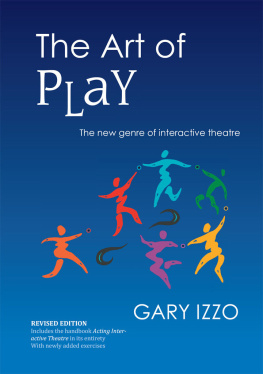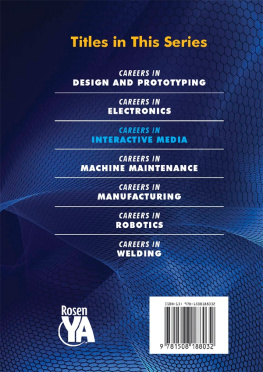The Art of Play
The New Genre
of Interactive Theatre

GARY IZZO
Copyright 1997 by Gary Izzo
All rights reserved. No part of this book may be reproduced in any form or by any electronic or mechanical means, including information storage and retrieval systems, without permission in writing from the publisher, except by a reviewer, who may quote brief passages in a review.
ISBN-13: 978-1519794239
ISBN-10: 1519794231
Library of Congress Control Number: 2015921008
CreateSpace Independent Publishing Platform, North Charleston, SC
Editor: Lisa A. Barnett
First Edition Production: Melissa L. Inglis
Cover Art Design: Julia Register
Digital Re-editing: Alice LaFae
This book is dedicated to
the inner child in us all
and to Madi.
Contents

About the Author

G ary Izzo is a stage director, producer, writer, performer, and creative consultant, and was one of the first directors to experiment in the interactive genre. As a teacher, he has trained hundreds of actors in improv, interactive and participatory theatre. As a director and producer he began his work in Renaissance festivals in the 1970's, and founded Creative Entertainment, Inc., a company dedicated to the exploration and production of audience-inclusive and environmental theatre styles.
Under Interactive Artists, Gary has worked as a show director/writer and entertainment consultant for the Walt Disney World Co., and was an early influence in Disney's use of live actors in interactive shows. He has designed and developed numerous interactive attractions across the globe for major entertainment companies such as Paramount Parks, Sea World, and Bush Entertainment.
Preface

T he form and content of theatre has always been shaped by what its culture needs in order to express itself. New theatre forms emerge from changing cultural conditions or attitudes. The information age we now revel in has connected us intellectually and separated us physically. We were once content to gather in community to watch as alternate reality played out upon the stage. We watched life dramatized before us while we were safe and disconnected in our seats, living it only vicariously from a distance. Ever since the written word was popularized, theatre has been a physical representation of the imaging process we experience when we read. Now, it seems, watching is not enough; we must take part. We seek now to play out our lives ourselves upon the stage, still within the same safety of make-believe.
Not surprisingly, even the software of our information age strives to be interactive. Yet ideas will never replace touch. We must still connect as human beings. Thus the place of live theatre in our culture will remain undiminished, but it will, as it must, adapt. This book discusses the process and techniques of interactive theatre, a new form of theatre that places the audience on the stage and in the midst of the drama. Unlike its participatory cousins, interactive theatre is both inclusive and reactive to its audience. It changes in response to the audiences influence. It also creates, or re-creates, a bond of community, and thus restores, if only for a few hours, our lost sense of belonging.
This revised volume includes both of Mr. Izzos books on interactive theatre. gives guidance for developing and performing an interactive production. It is a more practical guide to the interactive process, intended for the actor, director, and teacher.
This edition includes some revisions to the technique, and additional exercises. It has an expanded Table of Contents, an Exercise Index, and a of Terms to help you easily find your way to the information you need.
Acknowledgments

I would like to thank those actors over the years whose loyalty and trust gave me the strength to explore, and whose creativity, and faith in my process both inspired and defined its vision. I want to acknowledge the late Lisa Barnett of Heinemann Books for first giving this material a chance to be published, and Nancy Robbins for the support I needed to get all of this down on paper. To Doug Kondziolka and Baj Burinski, my great gratitude for their friendship and belief in me; and, most gratefully, to Baj for once giving me the key to unlock the heart of this odd corner of the theatre I was compelled to explore by answering my But, what is it? question with one brilliant insight, Its play.
Book I: Part I
Defining a
New Genre

Chapter 1
What Is
Interactive
Theatre?
Stepping Through the Looking Glass

M y first experience in the theatre was as a member of its largest and most important component: the audience. When I was nine years old, my parents took me to see a production of Man of La Mancha while we were vacationing in Boston. The production was staged in the round. I remember looking past the stage, to the far side of the vast arena, and seeing rows of attentive spectators seated quietly in the air-conditioned dark. The audience seemed huddled round the stage like cold campers around a fire, while the stage glowed warmly with the passionate adventures of Don Quixote.
At times I was aware of my place in the theatre, and at other times totally absorbed in the pageant unfolding within the circle of light below me. I was astounded by the magic of it--its power to move me. Within its orb the world of Don Quixote moved with perfect order. It wasted not a single sound, movement, or thought. It had a harmony, a beauty, a perfection all its own. All appeared so real and so close.
I was stricken with the notion that nothing separated that world from mine but a wide expanse of air and light. It seemed to have no borders. I felt a yearning to be there, to be inside that circle. I experienced for the first time the power of the theatre to lure the soul. I felt that tug of the spirit--its call to escape and join the illusion.
I thought to myself, "What if I could be there? What if I got up out of my chair, walked down the aisle, and stepped onto the stage fully prepared to help Don Quixote and Sancho save Aldonza from the muleteers. What would happen? Would they throw me a sword and cheer me on, or would they stand and stammer in surprise and anger as the house manager ushered me off of the stage, back to my seat and my mortified parents? This nine-year-old felt the later was the more likely, so I didn't attempt it, but the thought hung in the air like the sea of faces beyond the stage. Why must we be content only to observe? Why must the powerful spell of the theatre be held always at a distance, and why must it always dissolve when we reach out to touch it? That is the great mystery that I carried with me from my first play. It has remained my deepest fascination with the theatre.
Next page











